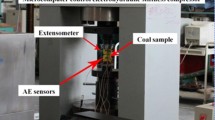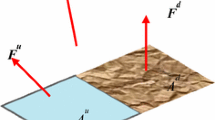Abstract
A three-stage model is introduced to describe the tensile failure process of rock and concrete materials. Failure of the material is defined to contain three stages in the model, which include elastic deformation stage, body damage stage and localization damage stage. The failure mode change from uniform body damage to localization damage is expressed. The heterogeneity of material is described with strain strength distribution. The fracture factor and intact factor, defined as the distribution function of strain strength, are used to express the fracture state in the failure process. And the distributive parameters can be determined through the experimental stress-strain curve.
Similar content being viewed by others
References
Jing, L., A review of techniques, advances and outstanding issues in numerical modeling for rock mechanics and rock engineering. International Journal of Rock Mechanics and Mining Sciences, 2003, 40(3): 283–353.
Yue, Z.Q., et al., Finite element modeling of geo materials using digital image processing. Computers and Geotechnics, 2003, 30(5): 375–397.
Wang, X.B., Stain localization and complete stress-strain curve of rock specimen in uniaxial tension. Chinese Journal of Rock Mechanics and Engineering, 2005, 24(Supp2): 5784–5788.
Liu, X.L. and Wen, B., Strain-softening behavior and description of concrete in uniaxial tension. Engineering Mechanics, 1998, A01: 8–18.
Hughes, B.P. and Gregory, R., Concrete subjected to high rates of loading in compression. Magazine of Concrete Research, 1972, 24(78): 25–36.
Popovers, S., A review of stress-strain relationships for concrete. ACI Journal Proceedings, ACI, 1970, 67(3): 243–248.
Guo, Z.H. and Zhang, X.Q., Experimentally study on complete stress-strain curve of concrete in uniaxial tension. Journal of building structures, 1988, 4: 45253.
Cao, W.G., et al., A study of statistical constitutive model for soft and damage rocks. Chinese Journal of Rock Mechanics and Engineering, 1998, 17(6): 628–633.
Xu, W.Y. and Wei, L.D., Study on statistical damage constitutive model of rock. Chinese Journal of Rock Mechanics and Engineering, 2002, 21(6): 787–791.
Shen, Z.J. and Chen, T.L., Breakage mechanic of geomaterial-structure types and load sharing. Chinese Journal of Rock Mechanics and Engineering, 2004, 23(13): 2137–2142.
Li, S.H. and Zhou, D., Formulation for damage of brittle materials and computational element based on criterion of strain strength distribution. Journal of Hydraulic Engineering, 2012, 43(s1): 8–12.
Li, S.H. and Zhou, D., Computation model of progressive failure plane in geological body and failure criterion of shear plan. Chinese Journal of Rock Mechanics and Engineering, 2013, z2: 3009–3015.
Li, S.H. and Zhou, D., Progressive failure constitutive model of fracture plane in geometrical based on strain strength distribution, International Journal of Solids and Structures, 2013, 50(3–4): 570–577.
Ansari, F., Stress-strain response of microcracked concrete in direct tension. ACI Materials Journal, 1987, 84(6): 481–490.
Wu, F., Experimental Study on Whole Stress-strain Curves of Concrete Under Axial Tension. Changsha: Hunan University College of Civil Engineering, 2006.
Lawson, et al., Solving Least Squares Problems. Englewood Cliffs, NJ: Prentice-hall, 1974, 161.
Bates, et al., Nonlinear Regression: Iterative Estimation and Linear Approximations. John Wiley & Sons, Inc., 1988.
Dennis, J., et al., Numerical methods for unconstrained optimization and nonlinear equations. Siam, 1996, 16.
Okubo, S. and Fukui, K., Complete stress-strain curves for various rock types in uniaxial tension. International Journal of Rock Mechanics and Mining Sciences & Geomechanics Abstracts, Pergamon, 1996, 33(6): 549–556.
Author information
Authors and Affiliations
Corresponding author
Additional information
Project supported by the National Program on Key Basic Research Project of China (973 Program, No. 2015CB250903) and CAS Strategic Priority Research Program (B) (No. XDB10030303).
Rights and permissions
About this article
Cite this article
Guo, R., Li, S. & Zhou, D. The Three-Stage Model Based on Strain Strength Distribution for the Tensile Failure Process of Rock and Concrete Materials. Acta Mech. Solida Sin. 29, 514–526 (2016). https://doi.org/10.1016/S0894-9166(16)30269-5
Received:
Revised:
Published:
Issue Date:
DOI: https://doi.org/10.1016/S0894-9166(16)30269-5




